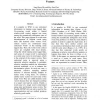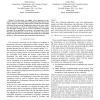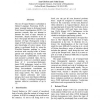119 search results - page 5 / 24 » Using Measures of Semantic Relatedness for Word Sense Disamb... |
COLING
2002
13 years 7 months ago
2002
It is popular in WSD to use contextual information in training sense tagged data. Co-occurring words within a limited window-sized context support one sense among the semantically...
EMNLP
2009
13 years 5 months ago
2009
In this paper, we address the task of crosslingual semantic relatedness. We introduce a method that relies on the information extracted from Wikipedia, by exploiting the interlang...
CORR
2004
Springer
13 years 7 months ago
2004
Springer
This paper describes the National Research Council (NRC) Word Sense Disambiguation (WSD) system, as applied to the English Lexical Sample (ELS) task in Senseval-3. The NRC system ...
IRCDL
2007
13 years 9 months ago
2007
Abstract— In this paper we suggest a new approach to represent text document collections, integrating background knowledge to improve clustering effectiveness. Background knowled...
COLING
2008
13 years 9 months ago
2008
The use of topical features is abundant in Natural Language Processing (NLP), a major example being in dictionary-based Word Sense Disambiguation (WSD). Yet previous research does...



